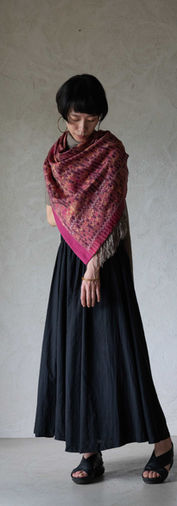
Textile
絣
ហូល
Today, the most representative Cambodian textiles, found in major museums and private collections worldwide, are traditional fabrics such as Sampot Hol and Pidan, created using the refined and intricate weft-ikat technique.
At present, there is no definitive evidence of when ikat weaving first began in Cambodia. However, in the bas-reliefs of Angkor Wat and Bayon—built during the Angkorian Empire, which began in the 9th century and reached its peak in the 12th century—there are depictions of daily life, including the garments of apsaras (celestial dancers) with their enigmatic smiles, showing fabrics combining floral motifs with geometric border patterns.
(From 1995 UNESCO report)
Centuries of tradition
live in their blood,
and in the way they carry themselves.
What is tradition if it is not passed on?
Tradition is not something to simply preserve—
tradition is something we create.
As I catch glimpses of the world in which Cambodian textiles have been made,
this is what I have come to understand.
Representative Khmer Traditional Textiles
 |  |  |  |
|---|---|---|---|
 |
Pidan
Among the ikat textiles found across Asia, the Pidan stands out as a representative and distinctive Cambodian textile. Many of its patterns carry religious significance. Historically, Pidan were used as canopies over Buddha statues or as altar hangings behind Buddha images. They are also sometimes displayed as wall hangings during weddings or funerals. Common motifs include temples, celestial maidens, elephants, nāgas, and the tree of life. Some older Pidan even feature sailing ships, a possible remnant of Cambodia’s maritime trade era.
 |  |  |  |
|---|---|---|---|
 |
Sampot Hol
The Sampot Hol refers to a skirt (waistcloth) in the Khmer language, with "Hol" meaning ikat. Its patterns are made using a minimum unit of four weft threads, combining geometric designs with natural motifs such as flowers and insects. It is said that there are over 200 different patterns. Traditionally, the colors used in Cambodian ikat are yellow, red, and brown (or black). In more complex designs, green and indigo are added, making a total of five colors. Classical patterns do not use any other colors, and all of these were naturally dyed.
 |  |  |  |
|---|
Phamong
Phamong is a plain fabric woven from threads dyed in different colors for the warp and weft, creating a unique iridescent sheen. It is said that there are 52 different color combinations for Phamong. One of the most representative is called Koh Tia, meaning “the color of a duck’s neck,” which features a subtle and beautiful green and purple iridescence reminiscent of a duck’s neck.
Other Types of Fabrics Produced at IKTT
At IKTT, in addition to traditional Cambodian textiles, we also create new fabrics that are based on traditional techniques and motifs passed down through generations, adapted to contemporary styles. If you would like to see more of IKTT’s products, please visit the following link.







